Physical Address
304 North Cardinal St.
Dorchester Center, MA 02124
Cornblath and Reisner established nearly 60 years ago that neonatal hypoglycemia was a significant cause of neonatal morbidity and mortality, yet the definition and management of neonatal hypoglycemia have remained unclear. The management of low blood glucose levels is one of the most frequently encountered issues in the newborn nursery. The blood levels of glucose upon which we base our decision making remain a matter of expert opinion rather than being evidence based. The truth is the data needed to establish blood glucose levels that should be treated in the newborn have not been definitive enough to gain consensus.
In fact, the lack of consensus has led to further confusion for the clinician, as two pediatric organizations, the Committee of the Fetus and Newborn of the American Academy of Pediatrics (COFN AAP) and the Pediatric Endocrine Society (PES) have provided expert opinion on the management of neonatal hypoglycemia that suggested different ranges of actionable blood glucose levels ( Figs. 4.1 , 4.2 ).
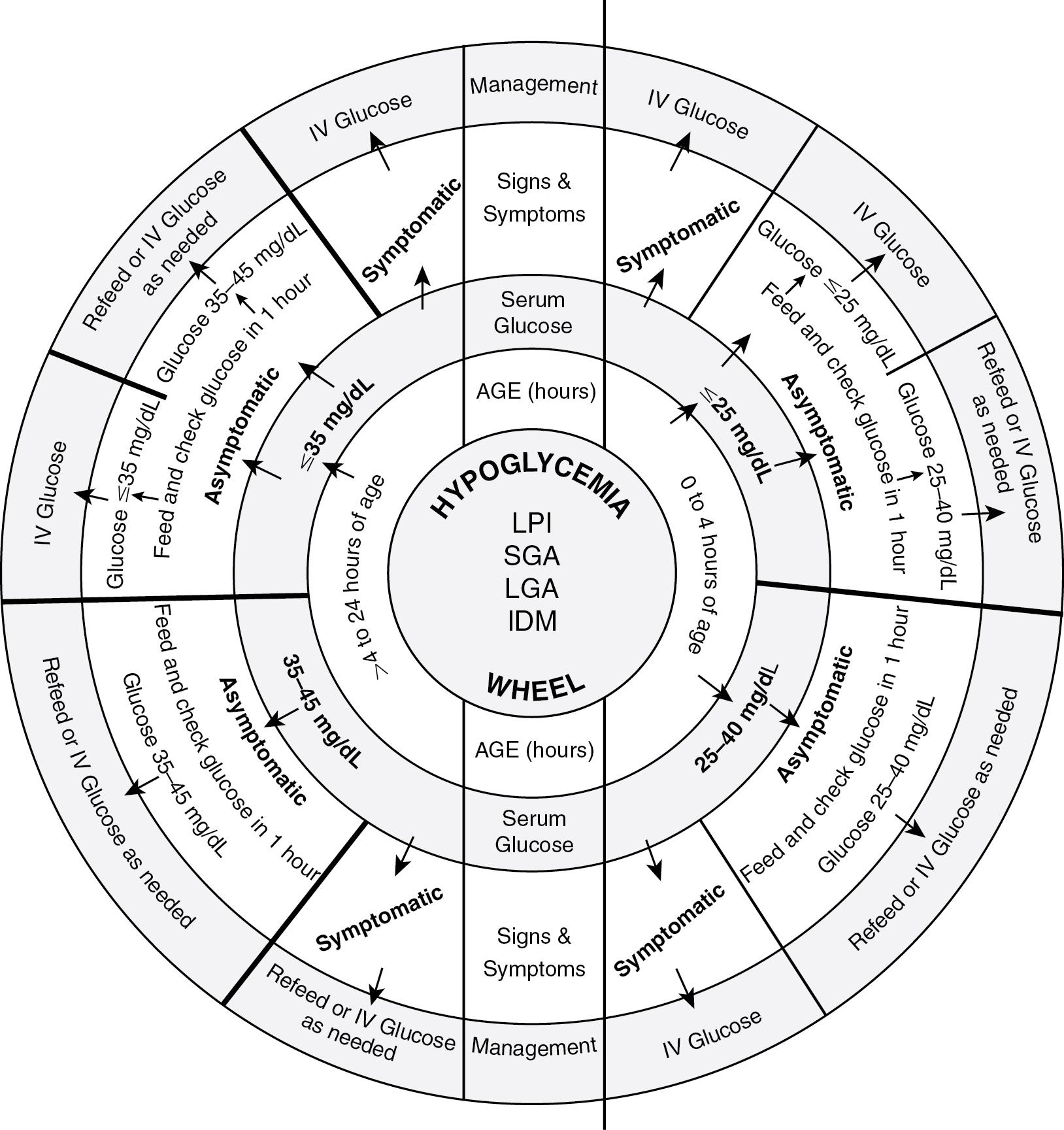
We will examine the controversies and discuss screening and management of neonatal hypoglycemia. An understanding of transitional neonatal hypoglycemia and postnatal glucose homeostasis is essential to develop strategies to keep infants out of the NICU because of hypoglycemia while still preventing neurologic sequelae.
A 34-year-old primigravida after an uncomplicated pregnancy is admitted in labor at 36 weeks’ gestation. The perinatal screening tests are negative, including a negative screen for group B Streptococcus (GBS) at 35 weeks’ gestation. Membranes rupture occurred 2 hours before vaginal delivery. Apgar scores were 8 and 9 at 1 and 5 minutes, respectively. The male infant weighs 2700 grams. The mother has planned to exclusively breastfeed the baby, and she begins in the delivery room with what is described as a “sluggish” first feed. Shortly thereafter, mother and baby are transferred to a postpartum room.
Before the baby being breastfed at 4 hours of age, the nurse on a routine assessment thinks the baby has slight tremors and she performs a point-of-care (POC) glucose level and it is 36 mg/dL. Apparently, the infant looks well enough to breastfeed because the nurse advises the mother to feed again. The nurse also suggests that after this breastfeeding the mother should supplement the infant with 1 oz of a term infant formula. She tells the mother that she will check the glucose again 1 hour after the formula feed to make sure the baby is no longer hypoglycemic. The mother is very disappointed that she will have to abandon her plan to exclusively breastfeed and wonders if it is absolutely necessary to give the formula. The follow-up POC glucose level is 52 mg/dL 1 hour after the formula feeding supplement, and the nurse’s note does not document any further tremors.
The nurse calls you at home and discusses the findings and tells you that the mother is disappointed about having to give formula supplement to her baby. You have your smartphone with you and you pull up the Glucose APP, “Sugar Wheel” ( Fig. 4.1 ) based on the algorithm from the Clinical Report—Postnatal Glucose Homeostasis in Late-Preterm and Term Infants published in Pediatrics in March 2011 from the American Academy of Pediatrics (AAP) Committee on Fetus and Newborn (COFN) ( Fig. 4.2 ).
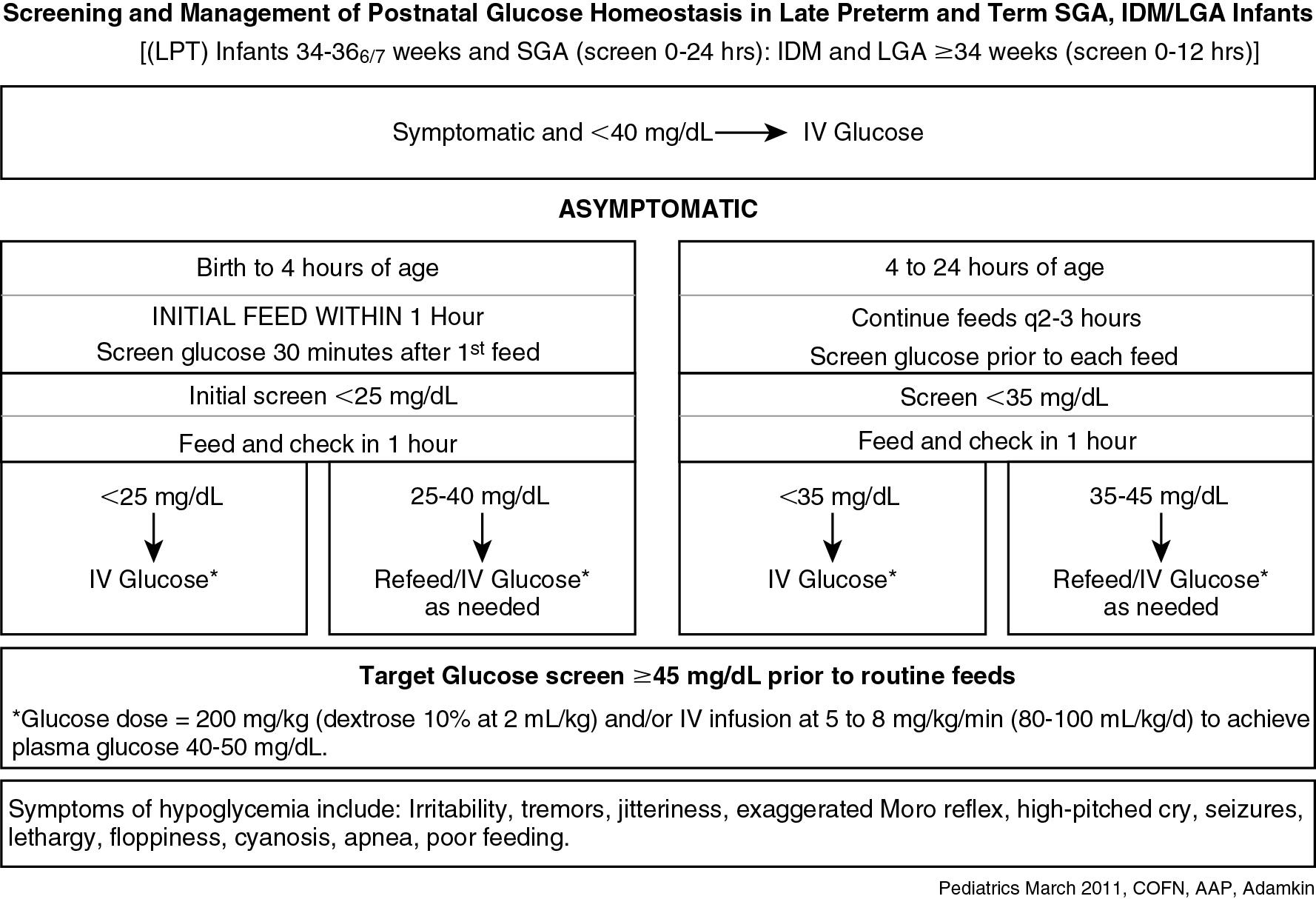
Should this late preterm infant have been screened sooner than age 4 hours?
Is this infant symptomatic, and does the infant’s glucose level (<40 mg/dL) require an immediate intervention?
Should a plasma glucose concentration have been sent to the laboratory at the same time as the POC glucose in this baby?
Should the infant simply have been left to continue breastfeeding, and are there other options?
Do infants who are exclusively breastfed have lower plasma glucose concentrations than those fed infant formulas?
Yes, this baby met high-risk criteria for neonatal hypoglycemia and should have been screened sooner because the baby was late preterm.
Yes, the tremors could be symptoms of hypoglycemia. Because symptoms of neonatal hypoglycemia are nonspecific, they often occur in newborns who are normoglycemic and have other problems. Jitteriness is just as likely among normoglycemic infants and those with a variety of other conditions. In addition, equally low blood glucose values are found in infants with no clinical signs (“asymptomatic hypoglycemia”). Therefore the presence or absence of symptoms cannot necessarily be used to discriminate between normal and abnormal blood glucose levels.
If symptoms are suspected and POC level is under 40 mg/dL, an immediate plasma glucose should be sent to the laboratory.
Yes, it is possible to have just continued the breastfeeding, because the symptoms were very mild and were actually associated with acceptable glucose levels. Other strategies might have included use of dextrose gel or donor human milk.
Breastfed infants may have lower plasma glucose levels than formula-fed infants.
After birth, the normal newborn infant’s plasma glucose concentration falls below levels that were prevalent in fetal life. This is part of the normal transition to an extrauterine existence, and through a series of triggers, the infant activates endocrine and metabolic events associated with successful adaptation. When this adaptation fails, perhaps secondary to immaturity or illness, there is a limitation of substrate supply, which may disturb cerebral function and potentially result in neurologic sequelae. A low plasma glucose may be indicative of this process but is not per se diagnostic. What is meant by “low”? How low is “too low”? At what glucose level does hypoglycemia lead to irreversible changes in brain structure or function?
A term, appropriate for gestational age (AGA) male was born by elective cesarean section after an uneventful pregnancy to a 30-year-old gravida 3 para 2 woman. Prenatal screening studies were normal, and Apgar scores were 6, 7, and 8 at 1, 5, and 10 minutes respectively. The baby seemed to have “wet lungs” in the delivery room and briefly received blow-by oxygen. By 3 minutes of age, oxygen saturations values were normal, and the respiratory distress resolved. On admission to the well-baby nursery at 30 minutes of age, this well-appearing infant had a POC glucose done apparently because of the cyanosis in the delivery room, and it was 27 mg/dL. A plasma glucose was then sent off, and it was 29 mg/dL. The infant was fed formula at 1.5 hours of age, and the repeat POC at 2 hours of age was 39 mg/dL.
Was this baby’s initial POC screen necessary?
When should screening for hypoglycemia take place, and was this infant’s screen obtained at the physiologic nadir for plasma glucose values?
The initial screen was not necessary, as this baby was asymptomatic and had not yet been fed.
In high-risk populations, screening for hypoglycemia should take place after the first feed. Yes, this sample taken within the first hour of life would represent the physiologic nadir for plasma glucose values.
Maintenance of glucose homeostasis via initiation of glucose production is one of the critical transitional physiologic events that must take place as the fetus adapts to extrauterine life. It is not uncommon for the transition to be difficult and result in an alteration in glucose homeostasis and an infant with a low plasma glucose level.
The fetus depends on maternal supply and the placental transfer of glucose, amino acids, free fatty acids, ketones, and glycerol for its energy supply. The normal lower limit of fetal glucose concentration is approximately 54 mg/dL (3 mmol/L) over most of gestation. Fetal glucose production does not take place under normal conditions.
The ratio of insulin to glucagon in the fetal circulation plays a critical role in regulating the balance between glucose consumption versus energy stored. The high fetal ratio results in activation of glycogen synthesis and suppression of glycogenolysis through the regulation of hepatic enzymes used for these pathways ( Fig. 4.3 ). Therefore in the fetus glycogen synthesis is enhanced and glycogenolysis is minimized. There is a rapid increase in hepatic glycogen during the last 30% of fetal life. This marked increase is associated with an increase in both circulating insulin and cortisol. The high insulin/glucagon ratio also suppresses lipolysis, which allows for energy to be stored as subcutaneous fat. This subcutaneous and hepatic reservoir establishes a ready substrate supply for the fetus to transition metabolically and establish postnatal glucose homeostasis ( Fig. 4.3 ).
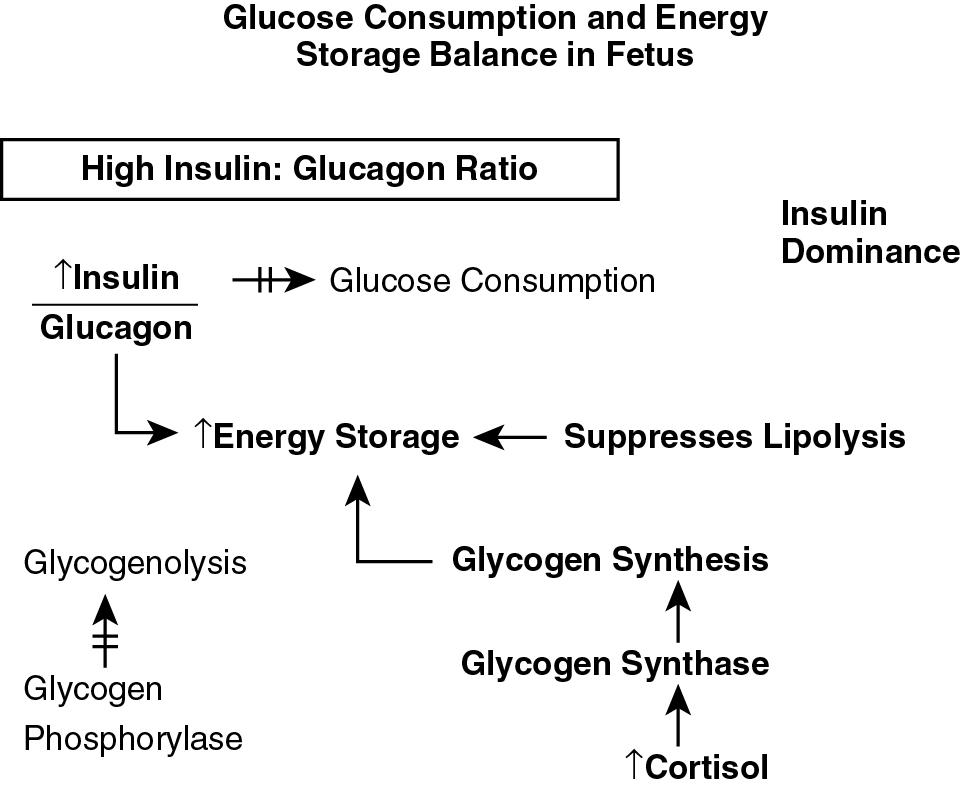
The dependence of the fetus on maternal glucose necessitates significant changes in regulation of glucose metabolism at birth following the abrupt cessation of umbilical glucose delivery. A number of physiologic changes allow the newborn to maintain glucose homeostasis ( Fig. 4.4 ). Catecholamine concentrations increase immediately after delivery, and this stimulates glucagon secretion. Therefore the insulin/glucagon ratio falls postnatally. This ratio is important because it drives events both in utero and during the postnatal adaptation to a decreasing glucose supply.
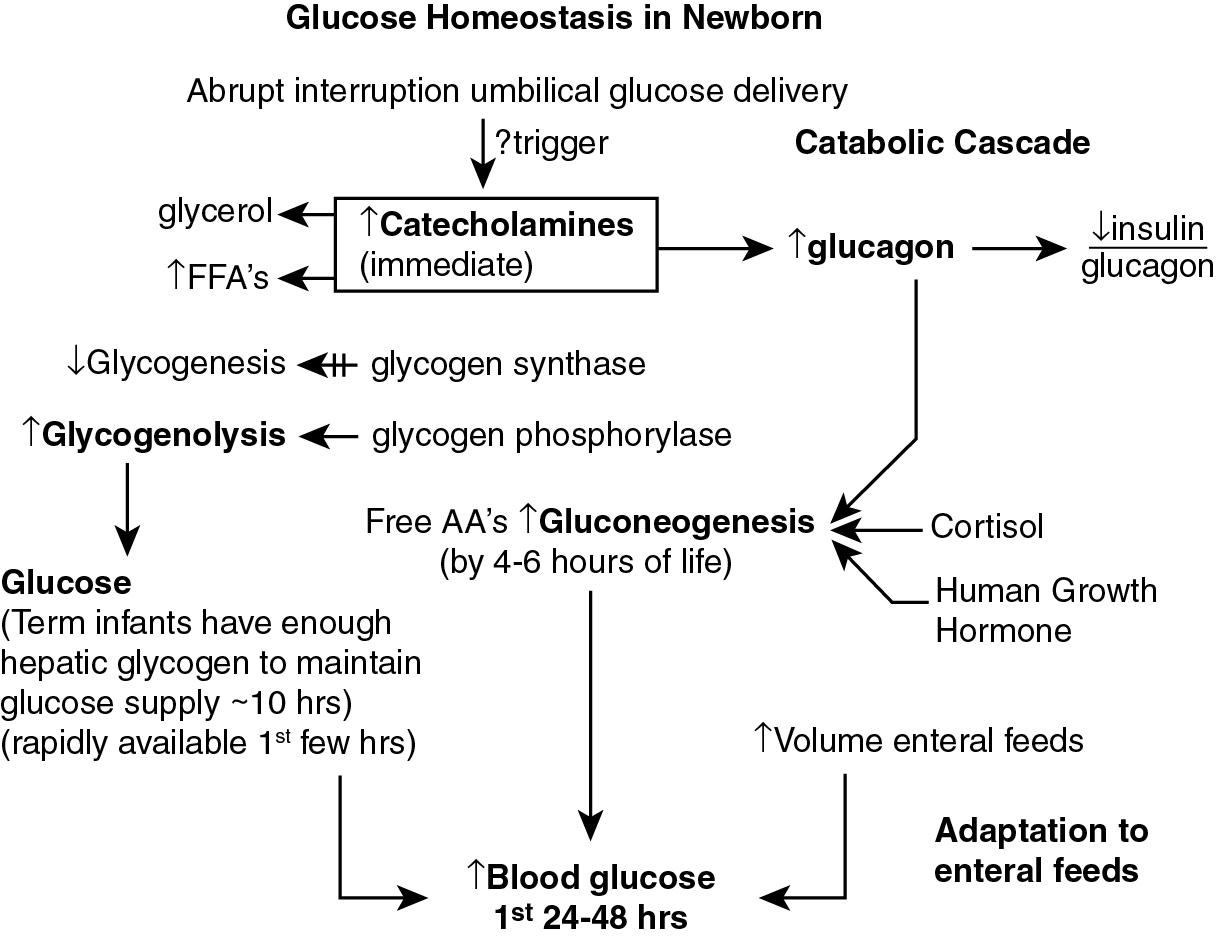
When glycogen synthase is inactivated and glycogen phosphorylase is activated following birth, this leads to stimulation of glycogenolysis and inhibition of glycogen synthesis, which is the exact opposite of the in utero fetal milieu. The release of glucose from glycogen provides a rapidly available source of glucose for the neonate the first few hours after delivery. The estimates are that for the term infant the hepatic glycogen supplies enough glucose for the first 10 hours. It is very important that other mechanisms eventually come into play to maintain glucose homeostasis ( Fig. 4.4 ).
The next important pathway for postnatal glucose homeostasis is gluconeogenesis. The high insulin/glucagon ratio after delivery induces enzymes required for gluconeogenesis. Free fatty acids are released secondary to surging catecholamines, which also increase glycerol and amino acid levels. By 4 to 6 hours of life, the term infant is capable of significant gluconeogenesis.
Until an exogenous supply of glucose is provided, either enterally or intravenously, hepatic glucose production is the most significant source of glucose to meet the needs of the infant. To maintain normal levels of hepatic glucose production, the infant must have the following:
Adequate stores of glycogen and gluconeogenic precursors (fatty acids, glycerol, amino acids, and lactate)
Concentrations of hepatic enzymes necessary for glycogenesis and gluconeogenesis
Normally functioning endocrine system (counterregulatory hormones, human growth hormone [HGH], and cortisol)
If any of these systems are not in place, then there is a disruption of glucose homeostasis, which increases the chances for neonatal hypoglycemia.
It has long been thought that preterm infants during the first 3 days of life had lower glucose values than term infants and they tolerated these lower levels better. This misconception came from the observation of lower plasma glucose levels in preterm infants who were commonly starved the first few days of life. These low values are no longer observed in preterm infants because of early intravenous nutrition and/or enteral feedings. However, within the first few hours after birth, the preterm infant has a significantly greater fall in glucose levels than in term infants, suggesting that they are less able to adapt to the cessation of intrauterine nutrition. Gluconeogenic ability is limited in preterm infants, possibly because of immaturity of the enzymatic pathways.
The physiologic responses described earlier were used by the AAP to determine the ranges for action and considered the rising levels for the asymptomatic infant from birth to 4 hours of age (transition), and then 4 to 24 hours of age ( Fig. 4.2 ). The AAP chose to name the figure Screening and Management of Postnatal Glucose Homeostasis rather than using the word hypoglycemia in the title. It seemed more logical to address the adaptation rather than to recommend absolute glucose levels needing treatment.
The AAP view of postnatal glucose homeostasis is that the infant’s blood glucose concentration is about 70% of the maternal level at birth and falls rapidly to a nadir by 1 hour of age as low at 20 to 25 mg/dL ( Fig. 4.5 , 4.6 ). This nadir is prevalent in healthy neonates and seen in all mammalian newborns. These levels are transient and begin to rise over the first hours and days of life. This observation is considered part of the normal adaptation for postnatal life that helps establish postnatal glucose homeostasis. Are there advantages to having a lower blood glucose concentration compared with adults the first 48 hours? A decrease in glucose concentration soon after birth might stimulate physiologic processes that are required for survival, including promoting glucose production through gluconeogenesis and glycogenolysis. Furthermore, the decrease in glucose concentration enhances oxidative fat metabolism, stimulates appetite, and may help adapt to fast-feed cycles.
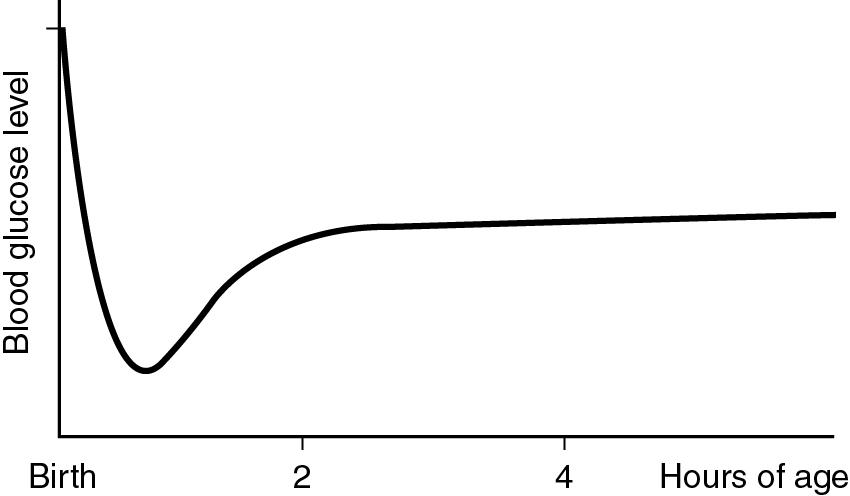
The AAP guideline during the first hours of transition uses the lower ranges of glucose values, not the mean values from fetal and neonatal data ( Fig. 4.6 ). It also emphasizes the clinical examination and condition of the infant. The AAP also investigated whether there was any reliable level of neuroglycopenia (the critical threshold of plasma glucose where brain injury occurs). No absolute level has been identified.
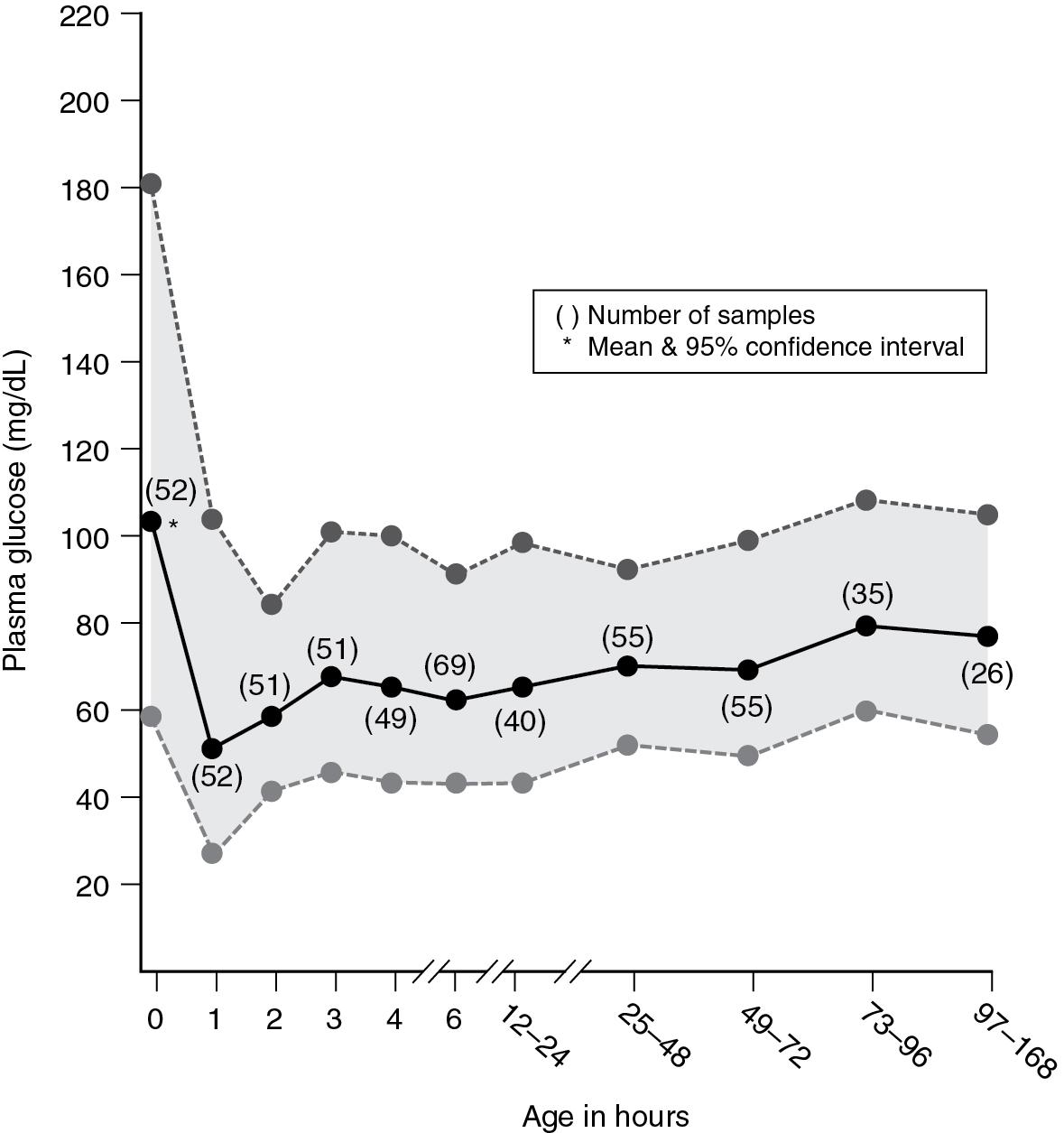
Following publication of the AAP recommendations, the PES provided a detailed description of this transitional neonatal hypoglycemia by examining metabolic and hormonal responses at various levels of plasma glucose ( Table 4.1 ). The strategy is routinely used in pediatric endocrinology for evaluation of hypoglycemia in older infants and children. This helps explain differences between the two organizations in their recommendations. The PES focuses on the concentration of glucose at which metabolic counterregulation occurs and that is used to define a “safe” lower limit for blood glucose concentration.
| High-risk newborns without a suspected congenital hypoglycemia disorder | 0–48 h | >50 mg/dL |
| >48 h | >60 mg/dL | |
| Neonates with suspected congenital hypoglycemia disorder and those requiring IV glucose to treat hypoglycemia | Any time | >70 mg/dL |
| The PES Set the above Thresholds Based on the Following Observations about the Impact of Specific Glucose Concentrations in Adults: | ||
| 55–65 mg/dL | Brain glucose utilization becomes limited | |
| 50–55 mg/dL | Neurogenic symptoms (palpitations, tremor, anxiety, sweat, hunger, paresthesia) perceived | |
| <50 mg/dL | Cognitive function impaired (neuroglycopenia, characterized by confusion, seizures, coma) | |
This unique period occurs during the first 48 hours in all mammals, not just human babies. It is characterized by a relative hyperinsulinism (transitional hyperinsulinism), low levels of ketones, inappropriate preservation of glycogen, and mean blood glucose levels at the nadir of 55 to 65 mg/dL. This resembles a known form of congenital hyperinsulinism in which the plasma glucose threshold for suppression of insulin secretion is lowered. This 55 to 65 mg/dL range, which is the mean range at the nadir, turns out to be the same level below which adults and older children demonstrate neurogenic symptoms. Therefore this observation along with the rest of the metabolic profile led the PES to suggest this was the critical range of glucose to maintain in newborn infants the first 48 hours.
The PES further argued that this range is where adults and older children activate neuroendocrine and metabolic mechanisms profiles for brain protection. The endocrine society also recognized that by 72 hours or so of life, glucose levels in the newborn rise to levels similar in older children and adults. Therefore the PES concluded that hyperinsulinemia accompanied by suppressed levels of ketones and inappropriately large glycemic responses to glucagon and epinephrine were consistent with a hypoketotic hyperinsulinemia.
When this transient form of hyperinsulinism ends and the glucose stimulus for insulin secretion matures, plasma glucose levels rise to over 70 mg/dL. Distinguishing transient neonatal hypoglycemia from a suspected persistent hypoglycemic disorder during an infant’s first 48 hours is very difficult. The PES thus recommends delaying any diagnostic evaluation until after 2 to 3 days of life to diagnose a persistent hypoglycemic disorder.
The PES document also noted that the plasma glucose concentrations of normal newborns studied from the 1950s and 1960s (when babies were fasted between 8 and 27 hours) were remarkably stable (mean value was 57 mg/dL) and unaffected by the timing of initial feeding or the interval between feeds. However, this fails to recognize that feedings do affect infants whose glucose concentrations are low, and although this appears to be a regulated process, it is not for those at greatest risk from hypoglycemia.
The fundamental question of how best to manage asymptomatic newborns with low glucose concentrations remains unanswered. Balancing risks of overtreating newborns with low glucose concentrations who are undergoing normal transition following birth against the risks of undertreating those in whom low glucose concentrations are pathologic, dangerous, and/or a harbinger of serious metabolic disease remains a challenge.
You are called to an emergency delivery for a 21-year-old primigravida woman at term gestation with no prenatal care and evidence of fetal distress. Rupture of membranes occurred 10 hours before delivery and Apgar scores were 6 and 7 at 1 and 5 minutes of life respectively. The male infant is vigorous in the delivery room with scant meconium staining, but the infant is macrosomic. The mother did not know if she had any abnormalities with glucose levels before or during the pregnancy. The baby weighs 4240 grams, and the length and head circumference (HC) are at the 50th percentile on the postnatal growth curves. The infant feeds sluggishly at 1 hour of age. At 6 hours of age, before the next feeding, he appears lethargic and jittery. He is offered a term formula but feeds poorly; the POC glucose level is 10 mg/dL.
What risk factors does this baby have for postnatal hypoglycemia?
When should this baby have been fed?
When should first screen for hypoglycemia have been performed?
Why is this symptomatic?
How should this infant be managed at 6 hours of life?
If treated and corrected by hour 48 of life, will the glucose level at 6 hours of life cause brain injury?
Become a Clinical Tree membership for Full access and enjoy Unlimited articles
If you are a member. Log in here